The fixture between Beşiktaş Jimnastik Kulübü and Fenerbahçe Spor Kulübü transcends a mere sporting contest; it is a seismic cultural event known as the Kıtalararası Derbi (Intercontinental Derby). The rivalry pits two of the "Big Three" clubs of Turkish football against each other, dividing the sprawling metropolis of Istanbul across the Bosphorus strait. While Galatasaray completes the trio, the Beşiktaş-Fenerbahçe clash is defined by an unparalleled raw, aggressive intensity, tactical complexity, and the relentless noise generated by two passionate fan bases.
This analysis will dive into the core of the rivalry's tactical profile, highlighting the key strategic elements that emerge when the Black Eagles and the Yellow Canaries take the pitch, often examining the 2020-2021 season’s 4-3 thriller as a case study for the derby’s inherent chaos and brilliance.
Historical Context and Identity
Dating back to 1909, the rivalry is rooted in the pursuit of Istanbul and, by extension, Turkish footballing supremacy. While often generalized as the Anatolian (Fenerbahçe) vs. European (Beşiktaş) divide, the reality is a competition of distinct cultural identities. Beşiktaş, historically associated with the old, affluent districts of Beşiktaş and Dolmabahçe, often portrays a bohemian, rebellious image. Fenerbahçe, rooted on the Asian side in Kadıköy, projects an image of enduring tradition and disciplined success. This clash of identities fuels an atmosphere where physicality and mental fortitude often outweigh pure tactical blueprint.
Statistically, the rivalry is incredibly tight, reflecting decades of closely contested matches, making every victory a monumental event in the title race.
Tactical Deep Dive: The 4-3 Masterpiece
The December 2020 match, where Beşiktaş overcame Fenerbahçe 4-3 at Şükrü Saracoğlu Stadium, serves as a quintessential example of the derby’s tactical high-wire act.
Beşiktaş's Clinical Transitions: Under Sergen Yalçın, Beşiktaş deployed a 4-2-3-1 formation that leveraged the speed of its wide players and the clinical finishing of Vincent Aboubakar. The crucial strategic element was the rapid transition from defense to attack. Beşiktaş allowed Fenerbahçe, typically fielding a solid 4-3-3 or 4-2-3-1 under Erol Bulut, to dominate possession in deeper areas. The Black Eagles then utilized aggressive high-press traps in the midfield to force turnovers, immediately channeling the ball to the wings.
This game saw the deployment of pacey full-backs, who often bombed forward to create overloads, turning the 4-2-3-1 into a 3-4-3 shape during attack. The goals often originated from direct, vertical passes, capitalizing on the space left behind by Fenerbahçe's adventurous full-backs. The two goals from Cyle Larin and Aboubakar’s brace highlighted the effectiveness of this direct, counter-attacking approach against a team seeking sustained possession.
Fenerbahçe's Possession Struggle: Fenerbahçe often finds itself trapped between controlling the midfield and trying to break down a deep-lying, highly motivated Beşiktaş defense. In the 4-3 defeat, their midfield, despite having greater ball retention, struggled to bypass Beşiktaş's pivot players and convert possession dominance into clear-cut chances. Their defensive frailties—particularly vulnerability to balls played in behind the defensive line—were ruthlessly exposed by Beşiktaş's directness. Furthermore, Beşiktaş’s use of high diagonal switches consistently stretched the Fenerbahçe backline, creating isolated 1v1 situations that favored the attacking side.
Enduring Tactical Blueprints
Regardless of the managers or the players involved, the derby tends to fall into three distinct tactical themes:
The Midfield Battle: Derbies are usually won or lost in the central area. Due to the high-stakes environment, both teams often field highly physical, ball-winning central midfielders. The priority is disrupting the opponent's rhythm, resulting in frequent fouls and a broken flow of play. Success hinges on which side can win the second balls and quickly establish a passing rhythm amidst the chaos.
Reliance on Set Pieces: Given the defensive compactness and difficulty in creating open-play opportunities, set pieces—both corners and free-kicks—become vital scoring avenues. Tactical planning around specific corner routines and the utilization of tall defenders (such as Attila Szalai or Domagoj Vida in recent years) for aerial duels is always a priority.
Goalkeeper Heroics and Mental Fortitude: The derby is a proving ground for goalkeepers. The extreme pressure means mistakes are amplified, and match-winning saves are legendary. Mentally, the team that manages the occasion best, avoiding rash challenges and maintaining tactical discipline despite the emotional pull of the fans, invariably gains the upper hand.
The Beşiktaş vs. Fenerbahçe fixture remains a dramatic, high-stakes collision of culture, history, and tactics. It is a contest where the tactical whiteboard often gives way to individual brilliance and raw, aggressive determination, ensuring its status as one of football's most compelling and unpredictable rivalries.








